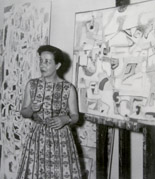
Marie Raymond was a leading female exponent of Abstraction Lyrique, along with Vieira da Silva. A member of the highly influential group of artists that were brought together by the critic Charles Estienne in 1946, Raymond was extremely successful in her personal exploration of abstract art. The group, which comprised of eminent abstract painters such as Hans Hartung, Gerard Schneider, Jean Deyrolle, and Jean Dewasne, gathered around the high-profile Galerie Denise René, on rue La Boétie in Paris, where they held several important exhibitions, including “Peintures Abstraites”, curated by Victor Vasarely 1947; “Tendences de l’Art Abstrait”, curated by Estienne 1948; and “Quelques Aspects de la Peinture Présente” 1949.
Having studied art with Gilioli at the École des Beaux Arts in Nice, Raymond exhibited at the major Paris salons during the 1930’s, the Salon d’Automne, Salon des Tuileries, and was a founding member of Société de Cagnes in 1937; but it wasn’t until 1938 that she began to explore abstraction. From 1943 she shared a house with one of the great masters of abstract art, Piet Mondrian, and whilst his theories and ideas were of a great inspiration to Raymond, she found her own conclusions were very different. Like Mondrian she was interested in Theosophist ideas, and herself became a Rosicrucianist aspiring to re-connect with the spiritual realm. Whilst she saw colour as the key to pure sensation, she believed it was necessary to integrate it into a space in which the mind was able to enter and transcend the material world. For Raymond the canvas itself could not become the primary focus, for her it was necessary to create a cerebral space with in the picture.
After the Liberation, Raymond was involved with the École de Puteaux, and began to exhibit at the avant-garde salons that emerged in Paris as part of the desire for rejuvenation, and from 1946 she exhibited at the Salon des Réalités Nouvelles, and the Salon des Superindépendants, where Charles Estienne discovered her and introduced her to the circle around Galerie Denise René. During the 1940’s she also exhibited at Galerie Colette Allendy with Serge Poliakoff, Pierre Soulages, and Gérard Schneider. In 1949 she began participating in the Salon de Mai, and was awarded the prestigious Prix Kandinsky, alongside Youla Chapoval.
Following her success in Paris, Raymond was soon attracting international attention, and began to exhibit extensively throughout Europe and abroad. In 1951 she was invited to represent France in the first Biennale of Sao Paulo; and in 1952 she participated in “Klar Form, 20 artistes de l’École de Paris” which travelled around Europe; aswell as an important show titled “École de Paris” which travelled through the United Kingdom; in 1955 she exhibited in “Du Futurisme à l’Art Abstraite” at Musée de Lausanne, with Picasso, Kandinsky, Klee and Villon; also in Rio de Janiero, at the Museum of Modern Art; and further abroad in Tokyo; 1956 Art Vivant, with Herbin, Vieira da Silva, Miro; in 1957 she had a major solo show at the Stedelijk Museum, Amsterdam; and in 1961, “Peinture Contemporain”, at the Musée d’Art Moderne, Paris.
During her career, Raymond also acted as the Paris correspondent to the avant-garde Dutch review Kunst en Kultuur, a role which she excelled in, hosting her famous Monday soirées of prominent figures to discuss art and ideas; and in 1954 held her famous unique interview with Henri Matisse. She was an intimate friend of Nicolas de Stael, and mother of Yves Klein with whom she later held several exhibitions. For her outstanding achievements Raymond was awarded the coveted Prix Marzotto in 1960. More recently, in 1993, her work was celebrated in a major retrospective at the Museé d’Art Moderne et Contemporain in Nice; and at the Musée des Beaux Arts, Angers in 2004; also "Femmes Années 50", at the Musée Soulages in 2020; and "Marie Raymond: at the Heart of Abstraction" at the Musée Tessé in 2021.
The artist is represented in several major museums of modern art including, Musée Nationale d’Art Moderne, Paris; Stedelijk Museum, Amsterdam; Museé d’Art Moderne et Contemporain, Nice.